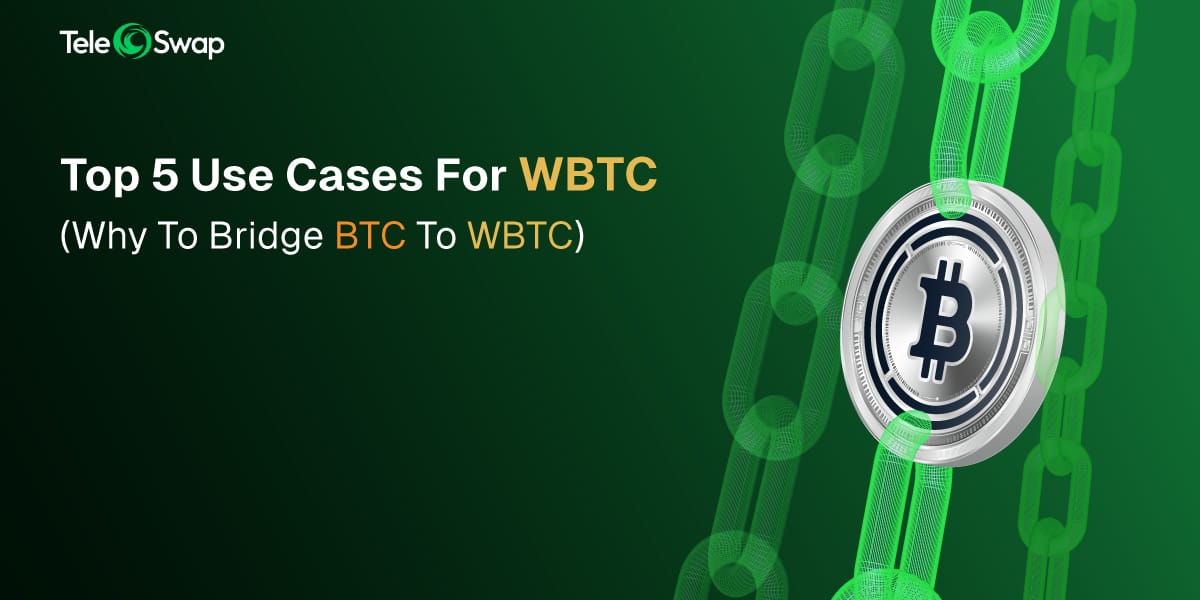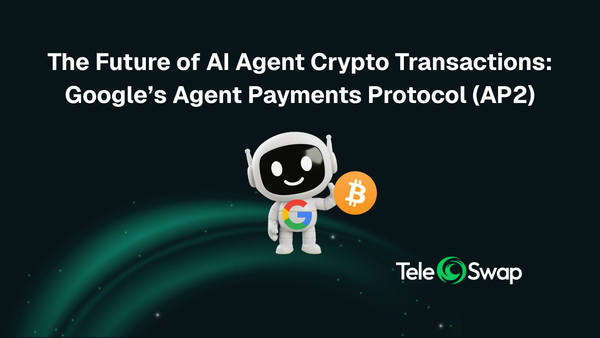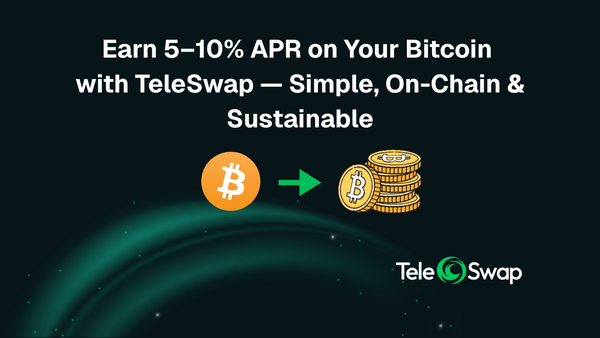Top 5 Use Cases for WBTC (why to bridge BTC to WBTC)

Bridging Bitcoin (BTC) with Wrapped Bitcoin (WBTC) unlocks powerful new possibilities for crypto users. BTC is the original cryptocurrency on its own blockchain, while WBTC is an ERC-20 token on Ethereum pegged 1:1 to BTC, allowing Bitcoin’s value to flow into Ethereum’s ecosystem. By bridging BTC to WBTC, you effectively “wrap” your Bitcoin for use in DeFi, and by bridging WBTC back to BTC, you “unwrap” it to regain native BTC. This process historically involved cumbersome steps through exchanges or custodians, but modern solutions like TeleSwap now offer one-click, trustless swaps. In this post, we’ll explore the top five use cases where BTC↔WBTC bridging shines, from DeFi yield farming to avoiding centralized exchanges. Whether you’re a casual BTC holder or a DeFi power user, these examples illustrate why bridging is so valuable in 2025.
1. Earning Yields and Participating in DeFi with WBTC
One of the biggest motivators for bridging BTC to WBTC is to put your Bitcoin to work in decentralized finance. Ethereum’s DeFi ecosystem offers yield farming, liquidity provision, and lending/borrowing opportunities that simply aren’t possible on the Bitcoin network. By converting BTC into WBTC, Bitcoin holders can supply liquidity on decentralized exchanges, stake WBTC in yield farms, or lend WBTC on money markets – all to earn interest and rewards on their otherwise idle BTC. For example, WBTC can be deposited as collateral on platforms like Aave or Compound to earn yield, or paired with ETH in a liquidity pool on Uniswap to collect trading fees. These DeFi yield opportunities let you grow your BTC holdings without selling your Bitcoin. Bridging via TeleSwap makes this especially convenient – you can swap BTC to WBTC and directly deploy WBTC into a DeFi app in minutes. TeleSwap’s decentralized bridge ensures you maintain self-custody during this conversion, so you can earn yields confidently while your Bitcoin stays under your control. (Read More: What is WBTC, and how does it differ from Native BTC?)
2. Using Bitcoin as Collateral for Loans and Stablecoins
Another major use case is using WBTC as collateral in DeFi to borrow assets or mint stablecoins. Wrapped BTC can be locked in lending protocols to take out loans – for instance, using WBTC in MakerDAO to mint DAI stablecoins, or in platforms like Aave to borrow ETH or USDC. This allows BTC holders to access liquidity without selling their BTC. By bridging to WBTC, you effectively unlock the value of your Bitcoin: you might deposit 1 WBTC and borrow against it to invest elsewhere, all while still retaining your BTC exposure. Many DeFi users also swap BTC to WBTC to take advantage of margin trading or leveraged positions in a decentralized manner. For example, you could convert BTC to WBTC, then use WBTC on a decentralized margin trading platform or as collateral on a derivatives exchange. These strategies were impossible on the Bitcoin network alone, but WBTC bridging brings Bitcoin’s liquidity into protocols that offer loans, leverage, and stablecoin issuance. TeleSwap makes this process seamless by providing a quick bridge directly from your BTC wallet to an Ethereum wallet holding WBTC. With a small 0.1% fee on TeleSwap’s trustless bridge, you can convert BTC to WBTC and immediately use it as collateral, avoiding the higher fees and slow withdrawals of centralized exchanges. (Related: How Much Does It Really Cost to Bridge BTC and WBTC?)
3. Decentralized Trading and Cross-Chain Arbitrage
Bridging between BTC and WBTC also empowers more flexible trading strategies. On Ethereum and other EVM networks, WBTC can be traded on DEXs (decentralized exchanges) against countless tokens – something you can’t do with native BTC on the Bitcoin network. By swapping BTC to WBTC, a holder gains the ability to trade BTC for altcoins, NFTs, or stablecoins on platforms like Uniswap or SushiSwap in a fully decentralized manner. This is great for users who want to diversify or react quickly to market opportunities without relying on a centralized exchange’s order book. Additionally, having BTC in WBTC form enables cross-chain arbitrage and faster trades. For instance, if WBTC is priced slightly differently on Ethereum vs. BTC on a centralized exchange, a trader can arbitrage that gap by moving between the two forms. Even beyond Ethereum, WBTC tokens (or similar wrapped BTC assets) can exist on other chains, so bridging BTC→WBTC can serve as a stepping stone to move Bitcoin value into other ecosystems. A practical example: imagine spotting a new token on Ethereum that you want to buy using some of your BTC – with TeleSwap, you could trustlessly bridge BTC to WBTC, then swap WBTC for that token on a DEX, all while avoiding exchange custody or withdrawal delays. Because WBTC transactions use Ethereum’s faster block times, you often get quicker trade settlement than waiting on multiple Bitcoin block confirmations. In short, bridging gives BTC holders wider trading access and speed, combining Bitcoin’s value with Ethereum’s flexibility.
4. Paying with Bitcoin in DeFi and Web3 Apps
As Web3 adoption accelerates, one of the most practical reasons to bridge BTC to WBTC is the ability to use your Bitcoin for payments and transactions across decentralized applications. While native BTC is ideal for long-term holding, it’s not natively supported by most DeFi platforms, NFT marketplaces, or blockchain-based services. In contrast, Wrapped Bitcoin (WBTC), as an ERC-20 token, integrates seamlessly into Ethereum and other EVM-compatible ecosystems. This means you can use your BTC, once bridged to WBTC, to buy NFTs, pay for in-game assets, tip creators, or interact with DeFi protocols that only accept ERC-20 tokens. Platforms like OpenSea, Lens, and dozens of play-to-earn games rely on token standards like WBTC, USDC, or ETH for transactions. By using a decentralized bridge like TeleSwap, you can convert BTC to WBTC in just a few minutes, without centralized exchanges, custodial risks, or KYC hurdles. This gives you instant, self-custodied access to the entire Web3 economy—while keeping your BTC mobile and useful. When you're done, you can just as easily convert WBTC back to BTC through TeleSwap and return to cold storage. Whether you’re making payments, collecting digital assets, or interacting with Web3 social platforms, bridging BTC unlocks real-world utility across the decentralized internet. (Related: What is WBTC, and how does it differ from Native BTC?)
5. Flexibility to Move Between Networks and Use BTC Anywhere
Finally, bridging BTC and WBTC provides maximum flexibility to use your Bitcoin across multiple networks and applications. Different blockchains have different advantages – by wrapping BTC, you can effectively take your Bitcoin into any compatible ecosystem and then bring it back to Bitcoin when needed. We’ve highlighted Ethereum’s DeFi, but consider that by 2025, there are layer-2 networks and cross-chain bridges expanding Bitcoin’s reach even further. Wrapped Bitcoin isn’t limited to Ethereum; there are similar wrapped BTC tokens on other chains (and WBTC itself can sometimes be ported to layer-2 solutions). The ability to seamlessly move value between BTC and these representations means you can always choose the best environment for your needs. For example, you might bridge BTC to WBTC to use it in an Ethereum NFT marketplace or blockchain game that accepts WBTC for purchases. Or you might try a newer network’s yield farm that offers rewards for Bitcoin liquidity by first wrapping your BTC. When you’re done, you can unwrap back to BTC to return to Bitcoin’s ultra-secure base layer for long-term holding. Bridging thus lets you have the best of both worlds: Bitcoin’s security and ubiquity, and other networks’ speed and dApp functionality. TeleSwap is instrumental in enabling this flexibility – it acts as a universal bridge for Bitcoin, so you’re not locked into one ecosystem. You can teleport your BTC into Ethereum’s world for a while, then teleport it back to Bitcoin, or even explore cross-chain swaps (TeleSwap’s technology is extending to networks like TON as well). The key point is that BTC↔WBTC bridging future-proofs your Bitcoin usage. You’re free to explore new crypto frontiers with your BTC and later consolidate back to the main chain, without ever giving up ownership or trusting a centralized custodian. (Related: Best Bitcoin Wallets in 2025)
FAQ (BTC↔WBTC Bridging Questions)
Q: How do I convert Bitcoin to WBTC? A: To convert BTC into WBTC (“wrap” your Bitcoin), you typically use a bridge or service that locks your BTC and issues WBTC on Ethereum. The easiest method is to use a decentralized bridge like TeleSwap. With TeleSwap, you just connect a Bitcoin wallet and an Ethereum wallet, specify the amount, and initiate the swap. The smart contract will take your BTC and release the equivalent WBTC to your Ethereum address in a single transaction. No sign-up or KYC is required. Alternately, some centralized exchanges allow trading BTC for WBTC, but those involve more steps and custody risk. Using TeleSwap or a similar trustless bridge is recommended for a quick, self-custodial conversion.
Q: How do I bridge WBTC back to BTC (unwrap WBTC)? A: Converting WBTC back to native BTC works the same way in reverse. On TeleSwap, you would connect your Ethereum wallet (with WBTC) and specify the Bitcoin address where you want BTC delivered. When you execute the swap, the protocol burns your WBTC and releases the equivalent BTC to your Bitcoin wallet. The result is that your WBTC is “unwrapped” back into regular Bitcoin. This process takes only a few minutes on TeleSwap, versus using a centralized custodian which could take hours or require identity verification. Always double-check the BTC address you provide when unwrapping, since Bitcoin transactions are irreversible.
Q: Are BTC and WBTC always 1:1 in value? A: Yes – WBTC is designed to maintain a 1:1 peg with Bitcoin. Each WBTC token is backed by one real BTC held in reserve by a custodian (e.g. BitGo), which is why their values track almost identically. In normal conditions, 1 WBTC = 1 BTC (minus negligible fees). Small price deviations can occur on exchanges due to liquidity or momentary demand imbalances, but arbitrage traders and the redemption mechanism correct them quickly. When you bridge through TeleSwap or redeem via the WBTC custodian, you always expect to get 1 BTC for 1 WBTC (excluding any fees). Do note that WBTC relies on the custodial reserve model, so its peg is as strong as the trust in those reserves. So far WBTC has maintained its peg reliably.
Q: What are the fees to bridge between BTC and WBTC? A: The cost to bridge BTC↔WBTC includes network fees and usually a service fee. On the Bitcoin side, you pay a BTC transaction fee to send your coins, and on Ethereum you pay gas fees to receive/send WBTC. Beyond that, bridge providers charge a fee for facilitating the swap. For instance, TeleSwap only charges 0.1% of the amount as a bridge fee, which is very competitive. Some alternatives, like THORChain liquidity pools or centralized exchanges, might effectively charge around 0.15–0.25% (or more when including spreads and withdrawal fees). Always consider both the explicit fees and hidden costs like slippage. TeleSwap’s 0.1% fee is transparent, and with its efficient routing, you avoid extra slippage costs. In short, bridging a small amount (say 0.1 BTC) might cost a few dollars in network fees plus 0.0001 BTC in TeleSwap fee – a small price for moving Bitcoin into Ethereum or back.
Q: How long does it take to swap WBTC for BTC, using TeleSwap? A: TeleSwap can complete a BTC↔WBTC bridge in just a few minutes in most cases. After you confirm the transaction, the swap often finalizes in under 3 minutes for typical trade sizes. This is much faster than using a centralized exchange, where you might wait 10–60 minutes for confirmations and processing. TeleSwap achieves this speed by using an optimized cross-chain mechanism (via TeleportDAO) that doesn’t rely on long custodial processes – once your transaction is detected and confirmed on one chain, the corresponding output on the other chain is released without delay. Keep in mind that very large transfers might occasionally wait for extra confirmations, but generally, you can expect your BTC or WBTC to arrive in a few minutes. It’s a quick and convenient way to move between Bitcoin and Ethereum compared to traditional methods.




